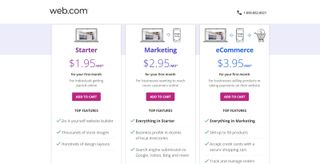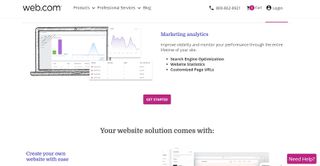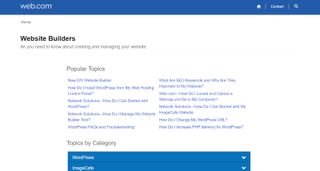Tom's Guide Verdict
Although it seems like a decent option on the surface, a deeper analysis shows that the Web.com website builder is barely usable, let alone good enough to compete with its more popular competitors.
Pros
- +
Decent analytics and reporting tools
- +
Competitive prices
Cons
- -
Poor customer service
- -
Confusing editing interface
Why you can trust Tom's Guide
In our search for the best website builders, we decided to take a closer look at Web.com. At first glance, this provider has both standalone website building solutions and expert site design services. It also offers SEO, marketing, and various other professional services. But it also has quite a few flaws.
In our comprehensive Web.com review, we take a closer look at the native website builder. By analyzing every aspect of the site creation experience, we deliver the crucial information that you should know before using Web.com.
Web.com: Plans and pricing

Although Web.com doesn’t offer a free trial or a “free forever” plan, it does have excellent introductory prices that are up there with the best that we’ve seen. That said, you will pay significantly more upon renewal.
For example, the Starter plan is available at a discounted rate of just $1.95 a month for the first month. However, this increases to $10 a month afterward, which is far from ideal. A Starter subscription will give you full access to the website builder and all standard site creation tools. You will also have access to hundreds of templates and an extensive stock photo library.
Upgrading to the Marketing package will cost you $2.95 for the first month (which renews at $15 a month). It includes everything in the Starter plan, along with marketing tools such as streamlined business directory listing and site submission to the major search engines.
Finally, the ecommerce package adds a selection of basic online selling tools. Prices start at $3.95 a month, increasing to $20 a month on renewal. You will be able to sell up to 50 products, accept payments through the secure payment gateway, and manage orders. Don’t expect anything too fancy here, but there are enough tools for those who want to sell a few products as part of their small website.
All plans come with a free domain, but do note that you will have to pay the high price of $38 a year to renew it if you cancel your Web.com subscription.
Web.com: Features

Web.com appears to offer a selection of decent features, although not everything is as good as it seems. Marketing and site performance analytics is one thing that Web.com does well. You will be provided with statistics and reports covering everything from the effectiveness of your SEO campaigns to what parts of the world your visitors are coming from.
Web.com claims to offer powerful ecommerce tools to help you create an attractive online store, though, it doesn’t. You can indeed list products, accept payments, and manage orders - but if you’re looking for anything more advanced than this, forget about it.
There is a wide selection of templates available through the Web.com template library, but these are rather disappointing. Many of them are incredibly similar to each other, and the designs tend to be outdated and average looking at best.
Web.com: Interface and in use

However, since there’s no free trial and no free-forever plan, you will need a premium subscription before you can even try the Web.com builder. The checkout process is smooth, though, and the low introductory prices make it easy to test the builder without spending a fortune.
One thing that we didn’t like was the fact that we had to pay for a subscription before finding anything out about Web.com’s templates or website builder.
When it comes to editing, basic customization is relatively straightforward. It’s easy to personalize simple text and media elements, but you will likely run into problems when you start trying to do anything more advanced. The templates are basic and outdated, and the drag-and-drop builder is clunky and hard to use.
Web.com: Support

Although Web.com appears to offer a decent selection of how-to articles and guides via its help center, a closer look shows that this really isn’t the case. There’s only a small number of articles under the website builder category, and most of these aren’t even related to the builder.
Live chat, phone, and email support are available for paying customers. However, we found it difficult to get a response via email, and the live chat agents didn’t seem to have much knowledge about the company’s products.
Alternatives to Web.com
Ultimately, Web.com isn’t a website builder that we can recommend. However, there are plenty of decent alternatives out there. If you’re looking for an affordable solution, consider HostGator’s Gator Builder. Prices start at just $3.84 a month, and its editor offers excellent pixel-perfect design flexibility.
Another great option is Weebly, especially if you want to add an online store to your new website. It has a suite of ecommerce tools, extremely attractive templates, and a foolproof editor. Prices start from just $6 a month, which also makes it a cheaper long-term option than Web.com.
Web.com: Final verdict
Web.com has its pros, which include competitive prices and excellent marketing tools, but there are just too many cons.
The ecommerce tools are rudimentary at best, the template library is exceedingly average, and the editor itself is clunky and confusing. Add awful customer support and a lack of transparency to the equation, and you can see why we recommend considering almost any other website builder over Web.com.
Further reading on website builders
We've highlighted 10 tips to follow when you build a website for the first time, and we've also covered the best ecommerce website builders and the best small business website builders in our buying guides for those use cases. If you want to use WordPress, you'll need to choose one of the best web hosting services offering the best WordPress hosting.
Daniel is a freelance copywriter with over six years experience writing for publications such as TechRadar, Tom’s Guide, and Hosting Review. He specializes in tech and finance, with a particular focus on website building, web hosting, and related fields.


